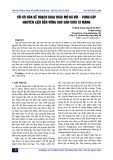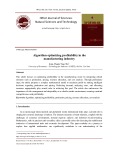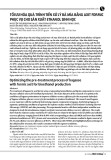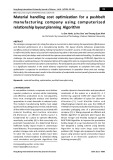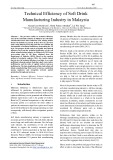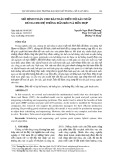
* Corresponding author Tel.: +966558555776
E-mail address: E-yhy-2008@hotmail.com (Y.H. Daehy)
© 2019 by the authors; licensee Growing Science.
doi: 10.5267/j.uscm.2018.12.007
Uncertain Supply Chain Management 7 (2019) 381–398
Contents lists available at GrowingScience
Uncertain Supply Chain Management
homepage: www.GrowingScience.com/uscm
Effective cost minimization strategy and an optimization model of a reliable global supply chain
system
Yahya H. Daehya*, Krishna K. Krishnana, Ahmed K. Alsaadia and Saleh Y Alghamdia
aWichita State University, United States
C H R O N I C L E A B S T R A C T
Article history:
Received November 2, 2018
Received in revised format
November 18, 2018
Accepted December 21 2018
Available online
December 24 2018
Attributable to high competition in global manufacturing market and outsourcing suppliers,
many supply chain systems have become more complex and faced with high risks and low
performance. Many financial losses and failures are likely to be due to risks among supply
chain's components. As a prescription to improve quality, performance, and profitability of the
supply chain, companies would like to measure and optimize the reliability of the entire supply
chain system. Also, companies are interested in minimizing the cost of processes and
improvement throughout the supply chain system. This paper explains a statistical method that
measures the reliability rate of each part in the system as well as the entire supply chain.
Moreover, the paper elucidates a mathematical model that improves the reliability of the supply
chain through minimization of cost components. The results and findings of this study confirm
that the proposed model can be applied to improve the supply chain system. Also, the system
can be improved to reach a designed reliability rate as given target to the model. The illustrated
methodology can be used as a guide on how to develop a reliable supply chain system plan
with low possible costs.
., Canada
b
y the authors; licensee Growing Science2019 ©
Keywords:
Supply chain system
Reliability optimization
Minimum cost
Reliability rate
1. Introduction
Globalization has a tremendous effect on manufacturing for both local and international industries.
Through expanding marketplace and high competition, globalization has put pressure on factories to
increase quality, flexibility, and serviceability, while maintaining competitive costs (Laosirihongthong
& Dangayach, 2005). More than 50% of the cost of the products are now tied to supply chain delivery
systems. Hence, companies are focused on reducing the costs associated with the supply chain and to
also mitigate the impact of uncertainty of demands using analytics and optimization of supply chain
system design. One of the most popular methods for maintaining a competitive advantage is to enhance
the value of suppliers, manufactures, and customers while efficiently performing supply chain system
activities. Consequently, most of the manufacturers show increasing concern about their supply chain
management applications (Goh & Pinaikul, 1998). An efficient supply chain management is a
significant multi-disciplinary subject in recent industrial fields and academic research. It increases
productivity and profit of organizations through the revolution of managing the companies with

382
sustained competitiveness (Gunasekaran et al., 2001, 2004). Supply chain system has become more
important in the industrial world which supply and deliver products to the final customers (Waller,
2003). Supply chain management is easier to conceptualize in manufacturing, since the physical flow
of product is there (Waller, 2003; Christopher et al., 2011).
The typical supply chain includes a network of suppliers providing raw materials, parts, components,
assemblies, subassemblies, and final products combined together with process and clients (Mentzer et
al., 2001, 2004). Effective supply chain includes carrying the right number of the right type of product
to the right destination at the required time while considering the minimum related costs throughout
different levels (Saad et al., 2002). The reliability of the supply chain system is one of the metrics for
determining its effectiveness. Reliability has various key roles to play through the supply chain in order
to have reliability rate (Liu & Peng, 2009). Even though the concept of supply chain reliability
measurement is not easy as an approach to measure the reliability of each activity in the chain, this
concept can help to identify indicators that have important contributions in order to measure the
reliability of supply chain (Cooper et al., 1997; Gu et al., 2013).
According to So (2000), it can be costly to deliver outstanding time performance when delivery time
performance depends on the operating efficiency of the system and the available capacity. In the
situation of time-sensitive products for example, products with various characteristics require
appropriate methods of managing the supply chain for such products. Moreover, these methods have
to take into consideration both the operational (and other) costs and the time as well. Therefore,
companies need to improve the adequacy of its delivery system to achieve the desired time performance
by spending minimum cost of operating (Eruguz et al., 2013).
Most of the research discuss measuring the reliability of a system from a subjective perspective. Most
of the studies focused on single-product supply chain system. Thus, there is a lack of significant studies
investigating the reliability evaluation and cost minimization in supply chain system. This research
aims to apply and develop an integrated supply chain reliability assessment framework and reduction
cost minimization strategy (Kleijnen & Smits, 2003). The method evaluates supply chain system by
taking different types of uncertainties into consideration. Thus, the proposed method has the potential
to accurately calculate the reliability of the whole supply chain. Besides, this method will enable
companies to make enhanced supply chain management decisions at any levels and to calculate the
reliability against each reliability computation factor. To achieve the overall objective of this research,
two main points were considered. First, we develop a methodology for ensuring the reliability of the
supply chain system, by improving the reliability of its entities. Secondly, we ensure that the
methodology also optimizes the cost of the supply chain system while achieving the required reliability.
2. Literature Review
2.1 Uncertainty of Global Supply Chain Systems
Supply chains are systems that operate within and across other systems, creating the operational
networks that may strengthen and develop or break and produce a negative effect on the organizations.
At this point, uncertainty is the greatest risk that a company can face, because it entails increase of risky
decision-making and controversial results from all parts of the production line. Although there is no
perfect supply chain either locally or globally, it is possible to approach the most appropriate conditions
by assessing various scenarios and developing action plans for diverse situations that are more or less
likely to occur to reduce uncertainty. This review studies the global supply chain as an appropriate
method to reduce cost and produce high-quality product. In addition, due to high uncertainty and
ambiguity, the global supply chain has negatively affected each component in the chain as well as the
overall supply chain. Consequently, in term of optimization, any improved model should be more
accurate and sensitive in order to build an effective global supply chain. Many challenges lead to better

Y.H. Daehy et al. /Uncertain Supply Chain Management 7 (2019)
383
understanding the risks and uncertainty in global supply chain which impact the competition in today's
business and market.
The previous findings reviewed for assessment of supply chain and risk avoidance demonstrated that
outsourcing could be a valuable and cost-efficient strategy (Li et al., 2014). The forecasts for the short-
term period suggest that outsourcing has a tendency to increase rapidly compared to the previous
results, because supply chain can be effectively optimized using proper resources, personnel, materials,
equipment, facilities, and even laws (some countries offer tax vacation or other privileges or bonuses).
Outsourcing has several benefits for the organizations, especially in the period or crisis or other
disruptions, including reduction of costs in a short-term perspective (usually, it concerns the current
financial period), and better access to assets. The history knows many examples of outsourcing that is
usually perceived negatively by local population that loses jobs and opportunities because companies
transfer their production lines to more appropriate locations that enable them to reduce transportation
and production costs. The present situation shows that outsourcing can also become a competitive
advantage that reduces production costs and brings the organization ahead of the competitors, enabling
the company to focus on the quality of their products and customer satisfaction and customer loyalty.
To conclude, supply chain and supply chain management have a number of categories that might
connect them to logistics, operations management, procurement, and other integrate parts of the
production process. While some scholars focus on the need to identify the terms accurately and
differentiate between supply chain and logistics, it is important to remember that the major difference
between these two concepts lies in the drives that push them and make them progress, as well as the
scale of decisions made based on certain data available. As such, logistics is the tactical decision-
making that does not have long-term perspectives and is more flexible in terms of changes and
adjustments. At this point, supply chain is the strategic decision-making driven by long-term
perspectives and the need to consider global and less internationalized networks for smooth operation.
In this paper, developing an optimization approach that recognizes the disrupted component that should
be optimized in order to fulfill the entire supply chain system reliability requirements with minimum
possible cost while taking uncertainty into an account.
2.2 Logistic and Cost of Global Supply Chain Systems
The current business environment creates fierce competition in the global supply chain to maintain cost
and to effectively meet customer requirements, forcing companies to focus on their SC logistics.
Typically, a supply chain process includes the production of raw products and materials at factories,
their further shipment to inventory locations to be kept for storage, and their delivery to retailers. The
development of effective supply chain strategies should be based on the consideration of exchanges at
different levels in this chain to achieve the reduction of cost and the improvement of robustness,
reliability, service, and resilience. The global supply chain should thus be better understood,
contributing to both reductions of system-wide cost and compliance with robustness, reliability,
service, and resilience requirements. This paper presents the research, which analyzes the
implementation of an effective global supply chain and identifies the extent of the effect of the areas
associated with robustness, reliability, service, and resilience on the organization’s performance
whereas reducing related cost. It was identified that remaining competitive in the modern challenging
business conditions in terms of the global supply change requires the development of the supplying
strategy to make the supply chain system effective and the focus on the significance of logistics in the
process of controlling the system robustness rate, reliability rate, service level, and resilience rate. It
will therefore allow for the attainment of cost effectiveness and efficiency throughout all levels of the
system.
In fact, there are two different points of view on quality in supply chain logistics: objective and
subjective. Objective quality is responsible for adjusting services to the requirements established by the

384
service provider. Quality here means an accurate measurement or assessment of all stages of the supply
chain process (Garvin, 1984). Subjective quality implies delivering quality services to the customer,
i.e. quality and supply chain logistics represents a global perspective related to the high standard of
service (Parasuraman et al., 2004). This paper offers a unique, developed objective quality
measurement that involves the robustness rate, reliability rate, service level, and resilience rate. The
major aspect of this measurement is its ability to assess the entire supply chain system and all members
of the system.
2.3 Reliability Design Optimization of Supply Chain System
According to Tu et al. (1999), numerous engineering designs have included traditional deterministic
optimization with the aim of consistently minimizing life-cycle cost and improving system quality.
Nevertheless, to avoid inaccuracy, there is a need to achieve variability and variation in material
properties, cost, manufacturing process, and system performance quality. The complexity and the
nature of processes are the major triggers of the occurrence of uncertainties in engineering design and
system. Therefore, robust design optimization (RDO) is necessary to decrease the effect of associated
uncertainty, system cost, and control quality. The current deterministic discrete optimization tools are
not as effective as RDO in case of uncertainty or dynamic conditions in optimization issues.
RDO represents a cost-saving optimization method, which leads to the reduction of the functional
variation of the system and saves the sources of variation. Taguchi was the first to present a robustness
method (Hwang et al., 2001; Taguchi, 1987; Taguchi & Phadke, 1988), which contributes to the
generation of a robust solution, and it is able to resist against uncertainties. According to Yadav et al.
(2010), there are three approaches within RDO: optimization procedures that rely on the series
expansion of Taylor, a robust design method that depends on the response surface methodology (Chen
et al., 1999; Eggert & Mayne, 1993), and Taguchi’s experimental design (Phadke, 1995). All
approaches of RDO aim at the minimization of the effect of performance uncertainties (variance)
associated with the mean values, retaining the cause of uncertainties to meet performance needs.
The review of literature demonstrates that research should be primarily focused on the cooperation
between a linked enterprise, which has an upstream supply chain system, and its effect on the overall
performance of the supply chain system. Therefore, the use of RDO plays an important role in a supply
chain system, developing a supply chain system with inherent robustness and reducing cost. The
implementation of RDO and involvement of its activities and aspects may result in the achievement of
a robust supply chain system. Almaktoom et al. (2014) focused on assuring service level robustness of
supply chain system. The mathematical model concentrates on reducing uncertainty and obtaining
robust system by implementing robust design optimization approach for service level. Generally, RDO
for SL mathematical model can be expressed as shown in Eq. (1).
min ,
,,
subject to
,,1,2,…, (1)
,
1,2,…,
0,1,2,…,
1
The objective function of Almaktoom’s (2017) mathematical model minimizes uncertainty and
processing time. The main constraints maintain required service level and the rest of the constraints
limit the model to run within allowed boundaries. Also, the decision maker has the advantage to weight
the objective function and move the model to focus on the desired part of the system. However, the
model has some consequences for the financial aspect in the organization which may raise the cost of
achieving robust supply chain system. In addition, the mathematical model has less ability to be

Y.H. Daehy et al. /Uncertain Supply Chain Management 7 (2019)
385
applicable for different sectors of businesses since most of the manufacturing facilities focus on a
reasonable (depends on types of product and organization goals) level of quality, high profit, and low
expenditures. The perspective of minimizing cost in Almaktoom’s work is not controlled which leads
to carry extremely high cost in order to accomplish the ultimate objective of the model.
3. Research Objective
The objective of this paper is to design a new strategy that improves the reliability of the supply chain
system by taking into consideration the minimization of the cost of improvement. The mathematical
model will ensure meeting reliability target for the supply chain system. Also, since the reliability rate
of the system will be enhanced, an amount of cost shall be invested to reach the required improvement.
The model will ensure the minimum possible cost of investment called the cost of reductions. Variation
reduction and processing time reduction are the two types of reductions that require costs to improve
them. Furthermore, the presented model will minimize these costs and maintain the reliability target
that the model to be obtained. Practically, different scenarios are considered in this study in order to
test different perspectives and figure out the most effective factors in cost and reliability improvement.
In the next section, the model will be explained into three parts. The first part is about the reliability
measurement and the function related to it. Then the second part has the mathematical model which
includes the objective function and the related constrains. The last part explains the mechanism of the
reduction cost function and the related types of costs which covered through the model.
4. Research Method
4.1 Reliability and Cost Optimization Model
The reliability rate of any entity in the supply chain can be calculated using the following equation:
∑
∑
, (2)
where, represents the reliability rate of entity number j to finish the required job. TT represents the
due time. represents the standard deviation (uncertainty) of entity distribution functions for entity
number j and represents the delay time at the same component. The optimization model is designed
to optimize the reliability of the supply chain system and minimize the cost of achieving the desired
reliability rate. The objective function (Eq. (3)) minimizes the cost of improving reliability of the supply
chain system that is associated with mean time reduction and standard deviation reduction. Eq. (4)
ensures that the achieved reliability for the supply chain is greater than the target reliability to be
achieved.
Eq. (5) ensures that the standard deviation for each entity is bounded by the upper and lower limits of
the achievable standard deviation. Eq. (6) ensures that the mean times that are obtained for each entity
is between the upper and lower bound of the achievable mean time for that entity. Eq. (7) ensures that
the mean time and standard deviation of all entities are not negative.
In this paper, the objective functions of all the entities are assumed to be equally significant. However,
cases are different from field to field; therefore, different weightings for objective functions of
components have been addressed by other scholars. Examples of unequally weighted objective
functions can be found in Deb (2001), Nixon et al., (2012), Rambau and Schade (2010), Konak et al.
(2006), Murata et al. (1996) and Yildirim and Mouzon (2012). In this study, the objective function will
not be weighted because of the equal importance of the cost at each part of the objective function which
ensures reducing mean time and standard deviation as well in the same component. Table 1
demonstrates the summary of the notations used for the proposed method of this paper.




